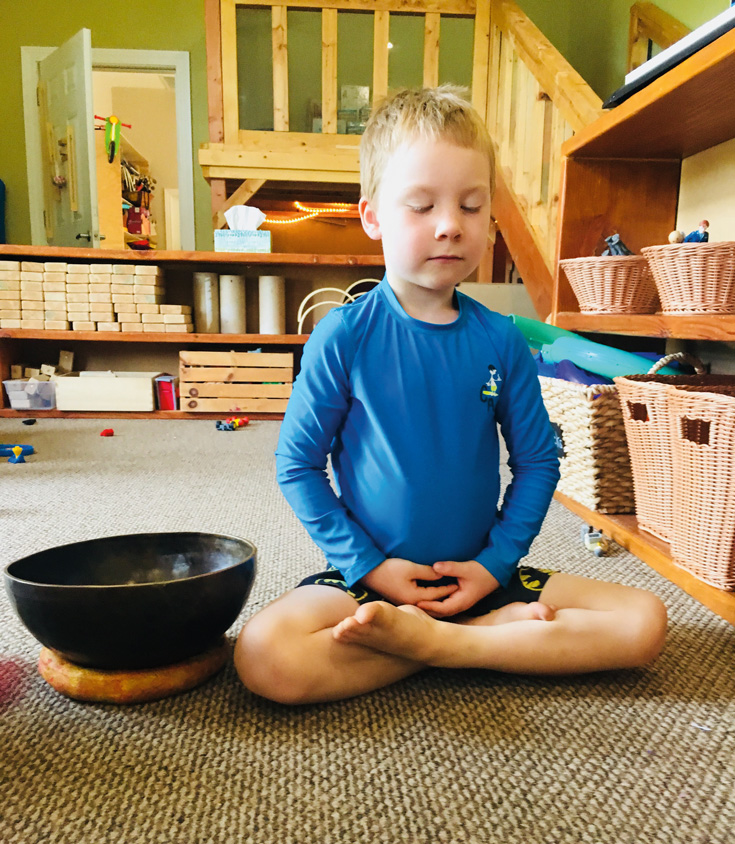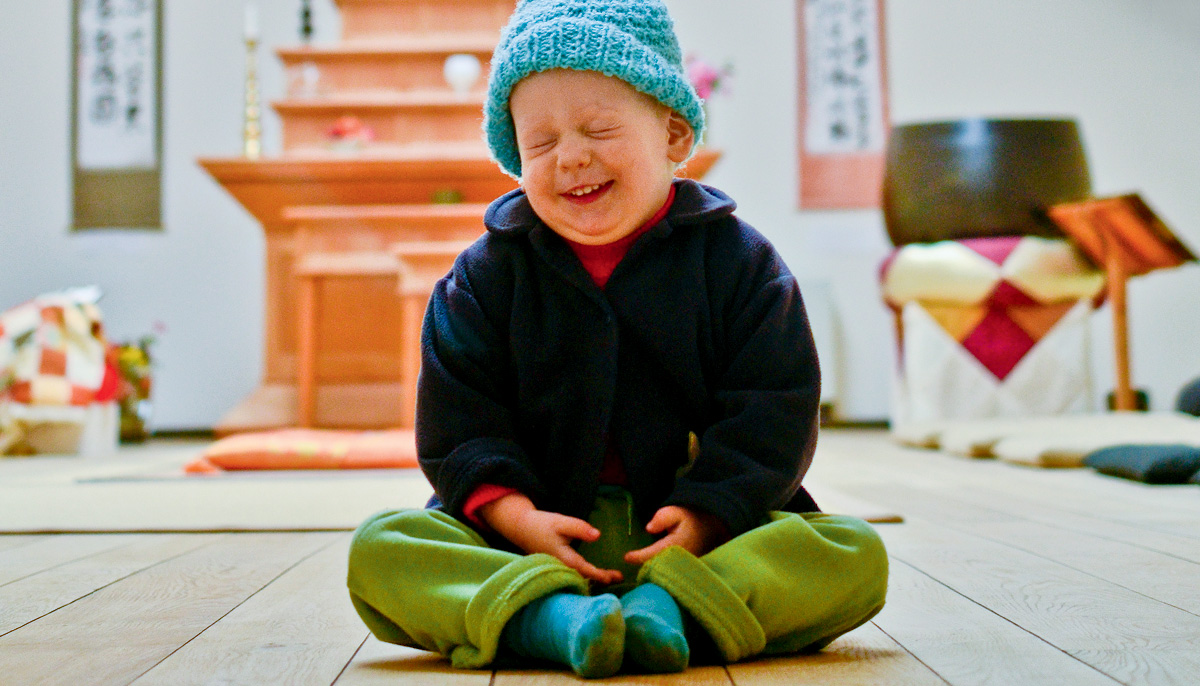I get it. The idea of meditating as a family engenders a dismissive laugh. You can’t even get your kids to hang up their coats or flush the toilet. That’s okay, though. As you flush away something left behind, make way for the fantasy that’s beginning to take shape. You can almost see it… the whole lot of you, sitting together peacefully in the early evening sunlight, breathing in and out.
A foundation for family meditation practice can actually be built upon just three layers: awakening curiosity for meditation, transforming curiosity into sustained practice, and collaboratively integrating meditation into family life.
Like any well-constructed structure, the lower layer supports the upper layers. In order to fully appreciate the importance of our first layer, awakening curiosity for meditation, we might bring to mind a commercial from the 1970s that featured a boy who wanted to know the precise number of licks needed to reach the center of his Tootsie Pop. He asked all the animals he encountered, but none knew. Eventually, a turtle told him, “Mr. Owl will know the answer, for he’s the wisest of us all.”
We can entice our children to arrive — on their own — for the practice.
I was intrigued by this commercial, and curiosity was exactly what the advertisers had been counting on. I didn’t even like Tootsie Pops, but I repeatedly exchanged my nickels for them and took them anywhere and everywhere—to the playground, up trees, and to the pea-green armchair by my family’s television set. Like the boy, I was trying to figure out how many licks it takes to get to the center. Yet, despite my due diligence, I was never able to answer the question any better than Mr. Owl.
But Mr. Owl was wise. For he must have known that the true answer wasn’t “three,” which is what he proffered before impatiently crunching his way to the center of the boy’s Tootsie Pop. Mr. Owl was wise to ensure that I wanted to come to the answer on my own.
To encourage our families to embrace meditation, we can employ a similar technique: we can entice our children to arrive—on their own—for the practice. The takeaway here is that the first step toward equipping youngsters with any kind of new skill is to arouse in them a curiosity to learn more about that skill. Only then can we support sustained practice and integrate it into everyday life.

Awakening Curiosity for Meditation
Children will come to meditation organically if they regularly see their parents practicing. With this in mind, next time you settle in to sit, you might sink into the family room sofa instead of running off to a secluded room and bolting the door behind you. For added allure, you might position yourself to face a window. Little ones, wondering what you’re watching, will snuggle in your lap and experience the comforting rhythm of your breath. Whether taking in a still blue sky or the business of life passing by, their breath is likely to align with yours.
Conscious modeling is more complex when it comes to older children who may not want to emulate anything their parents do. However, letting them experience the way meditation favorably impacts you, especially as it relates to their life, can pique their interest and motivate them to explore the practice. Once they’ve witnessed meditation’s transformative effect on you and experienced how it enables you to communicate more compassionately with them, you might include them in conversations in which you share an anecdote about how meditation has realigned your perspective on a particular stressor, or has improved your ability to communicate with a difficult colleague, or provided you with a renewed ability to manage a specific task.
Whatever you do, keep it fun. When I first introduced eating meditation to one of my children, I sat at the table with a bowl of blueberries. After examining the pretty little fruit and popping it in my mouth, I remarked that I was only able to chew the fruit a few times before it was all gone. “How many times can you chew a blueberry?” I asked, and the game ensued. It followed us on car rides and expanded to include other foods. Interestingly enough, my children always “won” even though I wasn’t trying to lose. With some creative forethought, nearly any practice can be made more playful.
Keep in mind that you’ll want to choose instructions that are meaningful and easily followed. If you want children to focus their attention on their breath, it’s best not to tell them to focus on their breath. Telling a child to focus on their breath is the equivalent of telling a laboring woman to “relax.” The words aren’t likely to go over well because they’re not useful or informative. Rather than telling your children to pay attention to their breath, you can suggest how they should do this. For example, you might propose that they notice how their breath feels as it enters their nose. You might ask, “Is it cool when it enters, and warmer when it leaves?” Maybe they’d rather explore whether their breath makes a sound or if it’s silent. Ask them if they’re able, with their mind’s eye, to follow their breath into their lungs and understand how their diaphragm moves their belly up and down like the sea. One of the simplest ways to use the breath to heel a wandering mind is through the act of counting breaths. See who can count to ten breaths and back down to zero without wandering too far afield.
Whatever you do, keep it fun.
Pairing the breath with movement can be especially helpful at the outset of a practice when the mind is a flurry and physical energy has yet to settle. An easy exercise is to guide your child to inhale their arms overhead into a balloon shape and to exhale their arms beside them as they let the balloon go. For best results, repeat the movement several times and encourage your little ones to let their balloons be whatever color they choose.
Walking meditation is a crowd pleaser with kids, and there are a variety of ways to practice it. You can walk slowly, linking your breaths to each step, you can count your steps, you can incorporate a mantra that aligns and repeats with each step, or you might simply walk, paying attention to where you step, the faces you pass, or the world before you. Consider having your family preselect designated paths for walking meditation. One week someone might designate the staircase as a place for practice, and another week someone else might decide that you should all practice while en route to bed. You don’t necessarily all have to practice walking meditation at the same time; the important thing is that you’re each practicing.
By practicing meditation techniques that draw on objects to appeal to the senses, meditation becomes developmentally accessible and engaging. Eating meditation provides an array of appealing opportunities for contemplative practice. You might chew slowly, focusing on scents, tastes, and textures, or you might count the number of bites needed to eat a certain food. Another form of eating meditation asks us to look deeply at our food and understand how it came to be before us. You might encourage your children to think about all of the people and forces in the world that were involved in getting that banana from the tree on which it grew into their hands. This “sourcing” of our food heightens appreciation of the food we’re eating and encourages us to eat more mindfully and healthfully.
To practice with sight, we can encourage kids to meditate with their eyes open and find a visual focal point, such as the horizon or the movement of neighborhood critters. To practice with sound, on the other hand, we’ll likely want to close our eyes to focus on what we’re hearing—the sound of the singing bowl, the repetition of a mantra, or early morning birdcalls. For scent, we might like to have flowers or fruit on our altars, and for touch, we might hold a small piece of clay in our hand to help us be still alongside our breath.
Inquiring about the practice lets your children know you’re interested in their experience while also helping them appreciate the impact the practice is having on them and the family. When using clay as a tactile prop, I like to first let children notice its consistency as they close their fingers around the piece I’ve provided. After meditation, I ask, “How is your clay different now that we’ve meditated?” Most children are thrilled to discover how malleable the clay has become after having been warmed in their hands during meditation. This can be a jumping off point for a discussion about how we too become less rigid and more agreeable post practice.
Picture books in which the characters benefit from meditation also inspire conversation. Books can be a precursor to the family practice or introduced as part of your regularly scheduled read aloud repertoire. To pique the interest of an adolescent who has outgrown picture books, you can suggest that they read the book to their younger sibling. The message won’t be lost on the big one, and when charged with the role of the reader, your older child will hold the lesson in higher regard.

Transforming Curiosity into Sustained Practice
Kids love to be in charge, so why not teach your little one how to sound the bell that launches your family practice? Similarly, they might guide you through a set of balloon breaths. Being the facilitator will serve to validate all they’ve learned and provide them with a sense of accomplishment.
Letting the whole family weigh in on the specifics of your collective practice, such as the length of time you will walk or the number of breaths for which you’ll sit, provides each person with a contributory role and ensures they’ll be more likely to want to participate since they’ll have a vested interest in the practice. Be sure to let children know how you value their important contribution and to include them in deciding even the basics, such as where, when, and how you’ll practice. For best results, and especially with younger children, you might present a few options.
At the suggestion of Thich Nhat Hanh, some families create a breathing room—a space reserved for quiet reflection where anyone is welcome to go at anytime. It can be its own room, or a part of another room. Ideally, there should be a rug for sitting, some blankets or cushions, and a bell or singing bowl. Maybe your little one can help arrange the space by putting the cushions in a circle and stacking them when the practice is over. Similarly, your children might help water the flowers that you keep in the room.
Having a notebook or journal, whether homemade or selected by your children, enables them to record their experience and reflect proudly upon it later. Designate a space for keeping track of the number of steps or breaths enjoyed, or the length of time spent sitting quietly. It can be incentivizing to notice how after only a few months, you’re all able to meditate much longer than when you first started. If your family shares one journal, you might designate a secretary to record family progress and a resident artist or photographer to capture the practice with images.
Sometime during the first few months of family practice, you might consider introducing a way to recognize that collectively you have reached certain practice landmarks or realized certain behavioral outcomes. As a group, you can decide on suitable rewards as well as when those rewards should be redeemed. If you all like going to the movies, then you might tally the number of mindful minutes or mindful breaths you’ve enjoyed as a family, and once you reach your designated goal, treat yourselves to a family movie night. If something material would be more appealing that is fine too. What’s important is to keep the value of the reward small in comparison to the value or benefit of the practice.
To shine a light on the connection between the practice and its benefits, you might have a check-in period at the beginning of each practice where family members share anecdotes of how a particular practice has impacted their behavior or speech toward themselves or another. Each story might earn the group a point and, once you’ve tallied enough points, you might earn a family dinner at a favorite restaurant or a day trip to the beach.
Once your children begin to recognize the benefits, there’ll be an intrinsic motivation for continued practice. Don’t expect anyone to jump up and down demanding their family practice, but do expect they’ll be ready to work with you to ensure that you all continue to practice together.
Collaboratively Integrating Meditation into Family Life
A way to ensure that you all show up for practice is to invest in a small blackboard or whiteboard on which any family member can at any time write a day and time that they’ll be in the breathing room that week. Beneath their name there should be spaces for everyone else to “sign up” to join them. The family member who first wrote their name and committed to practice might get to be the facilitator of the practice on that day. The hope is that this family member’s commitment will inspire at least a few others to sign on and arrive for the practice.
A planned family practice in the breathing room helps inform our less formal practice so that, for example, even a conversation can be a practice opportunity. When listening mindfully, we listen with six parts of ourselves: our eyes (on the speaker), our ears (tuned to the speaker), our mouth (still and quiet), our mind (on the speaker’s words), our body (aimed toward the speaker), and, of course, our heart (with empathy for the speaker). Be warned that once your family takes turns practicing deep listening, you may never want to talk again without having one another’s full attention.
It’s important to remember that meditation is one of the few health-based practices we can do in life that doesn’t require anything other than our body and our arrival, so your family can meditate anywhere and everywhere. Walking meditation, for instance, can take you to the bus stop or even to the ice cream shop where you can collectively enjoy eating meditation. In the spirit of asking questions, you might notice whether the last bite tastes as delicious as the first, or if you become satiated before finishing your ice cream. If prompted, maybe someone will be able to tell you precisely how many licks it takes to get down to the cone.
Or maybe you’d prefer to practice in the car. Whether on a family road trip or en route to school, you’re together, so why not take advantage of some of this time? You’re not likely to get anyone to part with their earbuds for very long, but you don’t need long. On a road trip, it’s as easy as having everyone stare out the window while someone (preferably not the driver) leads a ten-breath meditation at the top of each hour. With each successive hour, try adding ten breaths and by the time you arrive at your destination, you’ll have been meditating hourly for five to ten-minute increments. On a trip to school, try a daily practice that begins at the last traffic light and ends as you pull into the drop-off lane.
The car is also a great place to let your kids fire up their meditation apps and tunes (maybe they’re yours, but still, it’s something). Rather than playing a whole kid-centric meditation playlist at one time, you might introduce individual tracks at opportune moments or let your kids choose what tracks to enjoy. Better to leave them wanting more than wanting out.
As with most anything we present to our children, the way we share is as precious as what we share. Consider yourself as a consumer. If someone tapped you on the shoulder and said, “You should buy this product,” you’d be unlikely to buy it. Your money is a valuable commodity and you need a good reason to part with it. For children, their free time is their commodity, and if you tell them to do something or even ask them to do something, you may find that your request will be met with resistance. By thoughtfully and strategically laying a three-part foundation, you’re helping your family come to the practice organically and ensuring a more sustainable practice.

